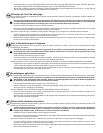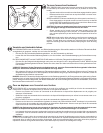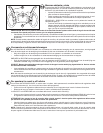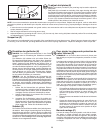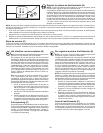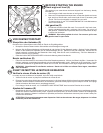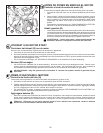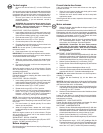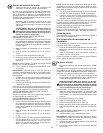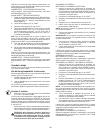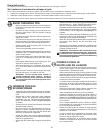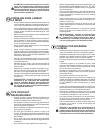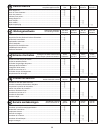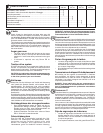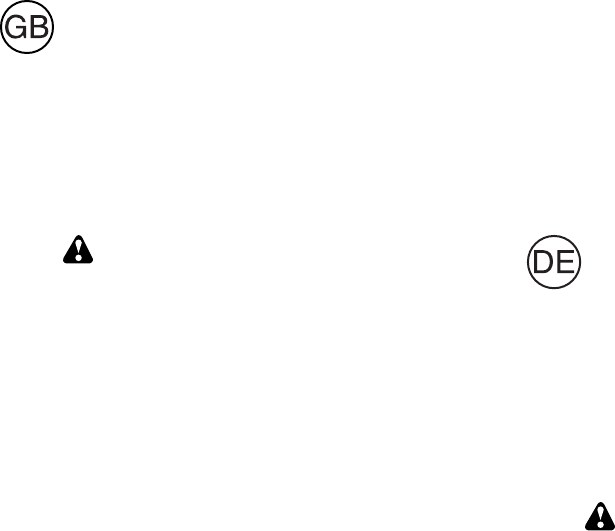
33
To start engine
• Be sure fuel shut-off valve (F) is in the OPEN posi-
tion.
Your snow thrower engine is equipped with both a 220 Volt
A.C. electric starter and a recoil starter. The electric starter
is equipped with a three-wire power cord and plug and is
designed to operate on 220 Volt A.C. household current.
• Be sure your house is a 220 Volt A.C. three-wire
ground ed system. If you are uncertain, consult a
licensed elec tri cian.
WARNING: Do not use the electric starter if your
house is not a 220 Volt A.C. three-wire grounded
system. Serious personal injury or damage to
your snow thrower could result.
COLD START - ELECTRIC STARTER
1. Insert safety ignition key (D) (tied to recoil start cord)
into the ignition slot until it clicks. DO NOT turn the key.
Keep the extra safety ignition key in a safe place.
2. Place throttle control (C) in “FAST” position.
3. Rotate choke control (E) to “FULL” position.
4. Connect the power cord to the engine (S).
5. Plug the other end of the power cord into a three-hole
grounded 220 Volt A.C. receptacle.
NOTE: Do not use primer (T) when starting engine with
the electric starter.
6. Push starter button (U) until engine starts.
IMPORTANT: Do not crank engine more than five continu-
ous seconds between each time you try to start. Wait 5 to
10 seconds between each attempt.
7. When the engine starts, release the starter button
and slowly move the choke control to the “OFF” posi-
tion.
8. Disconnect the power cord from the receptacle first,
then from the engine.
Allow the engine to warm up for a few minutes. Engine
will not develop full power until it has reached normal
operating temperature.
WARM START - ELECTRIC STARTER
Follow the steps above, keeping the choke control (E) in
the “OFF” position.
COLD START - RECOIL STARTER
1. Insert safety ignition key (D) (tied to recoil start cord)
into the ignition slot until it clicks. DO NOT turn the key.
Keep the extra safety ignition key in a safe place.
2. Place throttle control (C) in “FAST” position.
3. Rotate choke control (E) to “FULL” position.
4. Push the primer (T) four (4) times if the temperature is
below –10°C (15°F), or two (2) times if temperature is
between –10°C & 10°C (15°F & 50°F). If temperature
is above 10°C (50°F), priming is not necessary.
NOTE: Over priming may cause flooding, preventing the
engine from starting. If you do flood the engine, wait a
few minutes before attempting to start and DO NOT push
the primer.
5. Pull recoil starter (V) handle quickly. Do not allow
starter rope to snap back.
6. When the engine starts, release the recoil starter
handle and slowly move the choke control to the “OFF”
position.
Allow the engine to warm up for a few minutes. Engine
will not develop full power until it has reached normal
operating temperature.
WARM START - RECOIL STARTER
Follow the steps above, keeping the choke (E) in the “OFF”
position. DO NOT push the primer (T).
Before stopping
Run the engine for a few minutes to help dry off any mois-
ture on the engine.
If recoil starter has frozen
If the recoil starter has frozen and will not turn the engine,
proceed as follows:
1. Grasp the recoil starter handle and slowly pull as much
rope out of the starter as possible.
2. Release the recoil starter handle and let it snap back
against the starter.
If the engine still fails to start, repeat the above steps or use
the electric starter.
Motor anlassen
• Stellen Sie sicher, dass das Benzin-Absperrventil (F) auf
Position “OPEN” steht.
Der Motor Ihrer Schneefräse ist sowohl mit einem 220Volt A.C.
Elektrostarter, als auch mit einem Anreißstarter ausgestattet.
Der Elektrostarter ist mit einem dreidrahtigen Netzkabel und
Netzstecker ausgestattet, und ist für den Betrieb bei einem
Haushaltsstrom von 220 Volt A.C. geeignet.
• Stellen Sie sicher, dass Ihr Haus ein geerdetes 220 Volt
A.C. Sicherheitssystem besitzt. Falls Sie sich dessen
nicht sicher sind, befragen Sie einen Elektriker.
WARNUNG: Verwenden Sie den Elektrostarter
nicht, falls Ihr Haus kein geerdetes 220 Volt A.C.
Sicherheitssystem besitzt. Dies könnte ernsthafte
Verletzungen oder Schäden an Ihrer Schneefräse
zur Folge haben.
KALTSTART - ELEKTROSTARTER
1. Stecken Sie den Sicherheitszündschlüssel (D) (Mit dem
Startseilzug verbunden) in das Zündschloss, bis es klickt.
Schlüssel NICHT umdrehen. Bewahren Sie den Ersatz-
sicherheitszündschlüssel an einem sicheren Ort auf.
2. Stellen Sie den Gashebel (C) auf Position “FAST”.
3. Drehen Sie den Choke-Bedienungsknopf (E) auf Po si tion
“FULL”.
4. Schließen Sie das Netzkabel am Motor an (S).
5. Schließen Sie das andere Ende des Netzkabels an eine
geerdete 220 Volt A.C. Schutzkontaktsteckdose an.
HINWEIS: Bei elektrischem Motorstart nie die Einspritzvor-
richtung (T) verwenden.
6. Drücken Sie den Startknopf (U), bis der Motor ans-
pringt.
WICHTIG: Kurbeln Sie den Motor nie länger als fünf Sekunden
lang zwischen jedem Startversuch an. Warten Sie zwischen
den Startversuchen 5 bis 10 Sekunden.
7. Sobald der Motor anspringt, lassen Sie den Startknopf los
und bewegen Sie den Choke-Bedienungsknopf langsam
in Richtung der “OFF” Position.
8. Stecken Sie das Netzkabel erst aus der Steckdose, dann
aus dem Motor aus.
Lassen Sie den Motor ein paar Minuten lang warmlaufen.
Der Motor wird seine volle Leistung erst bei normaler Betrie-
bstemperatur erreichen.
WARMSTART - ELEKTROSTARTER
Folgen Sie den obigen Anweisungen und lassen Sie dabei
den Choke-Bedienungsknopf auf Position “OFF”.
KALTSTART - ANREISSSTARTER
1. Stecken Sie den Sicherheitszündschlüssel (D) (Mit dem
Startseilzug verbunden) in das Zündschloss, bis es klickt.
Schlüssel NICHT umdrehen. Bewahren Sie den Ersatz-
sicherheitszündschlüssel an einem sicheren Ort auf.
2. Stellen Sie den Gashebel (C) auf Position “FAST”.
3. Drehen Sie den Choke-Bedienungsknopf (E) auf Po si tion
“FULL”.
4. Bei Temperaturen unter –10°C (15°F) betätigen Sie die
Einspritzvorrichtung (T) vier (4) mal, bei Temperaturen über
–10°C & 10°C (15°F & 50°F) zwei (2) mal. Bei Tempera-
turen über 10°C (50°F) ist kein Einspritzen notwendig.




